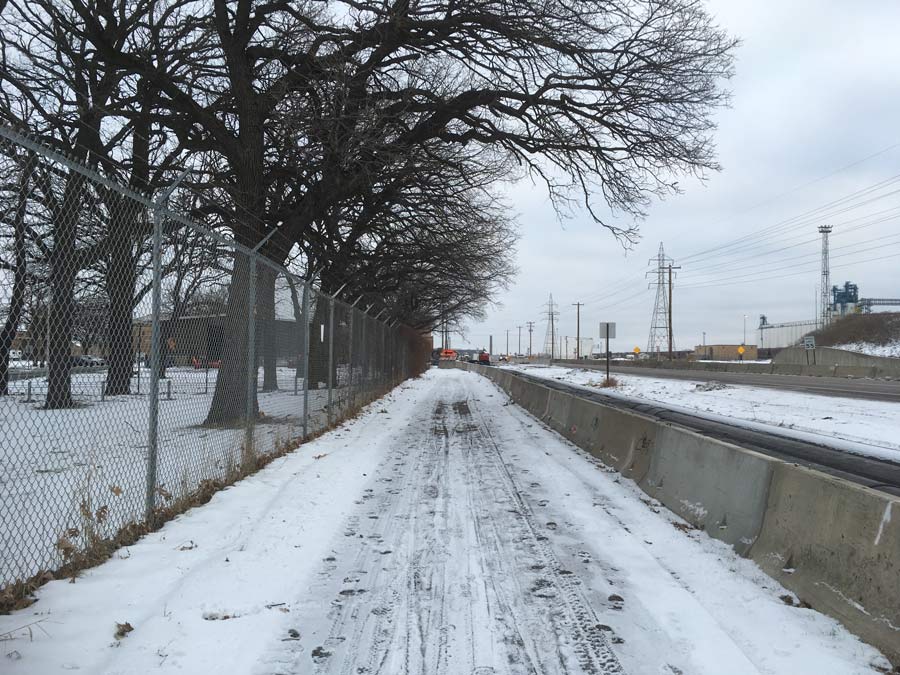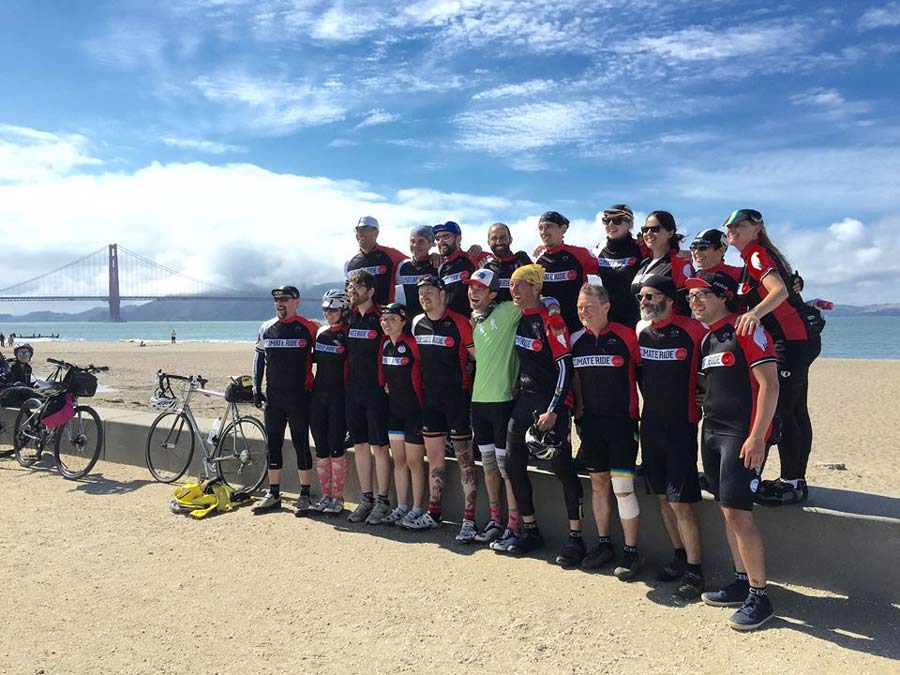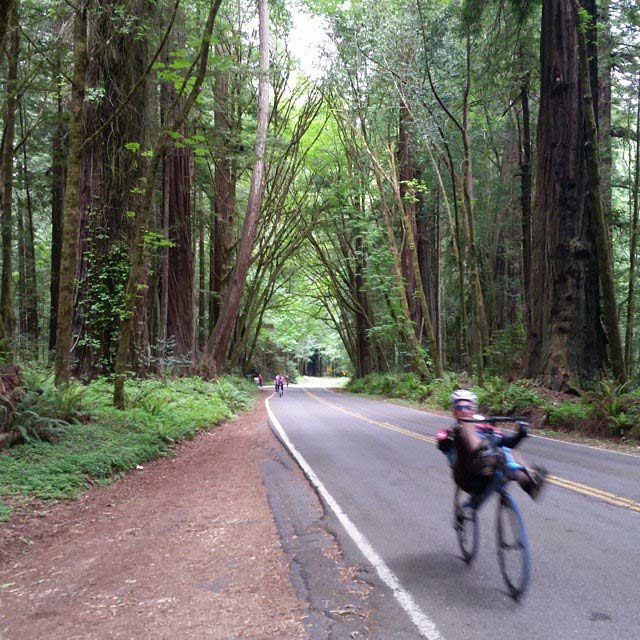 Ben, Colin, & Steph on Bike to Work Day.
Ben, Colin, & Steph on Bike to Work Day. River view along the Mississippi River Regional Trail.
River view along the Mississippi River Regional Trail.“There is no trail maintenance during the winter, including plowing and clearing. Please follow the posted detour routes. Thank you for your patience during this process.”
 Map of the closed trail section. Note the detour (yellow) takes riders across the river–opposite the side Dero is located.
Map of the closed trail section. Note the detour (yellow) takes riders across the river–opposite the side Dero is located. View of the plowed trail.
View of the plowed trail. A plowed trail means Bri is happy. Thumbs up!
A plowed trail means Bri is happy. Thumbs up!
What Makes a Good Bike Rack?
By Lou Fineberg
National Advocacy Accounts Manager
This post originally appeared on Strong Towns during their Bike Week.
A bike rack is a bike rack, right? If you’ve seen one, you’ve seen them all… Actually, bike parking is not quite that simple. For nearly 15 years, I have been closely involved in bike parking. As an advocate, I co-founded Bike Pittsburgh, and now, working for Dero in the bike parking industry, I interact with bike advocates nationwide. Here are my observations about bike parking done right.


LOCATION, LOCATION, LOCATION
Bicycle parking should be located in an easily accessible area that is well-lit, secure, and preferably sheltered. It should be placed as close to the building entrance(s) as possible, or at least as close as the nearest car parking. When done well, bike parking can enhance a space, make people with bikes feel welcomed, and even encourage more people to ride. When done poorly it can convey indifference, cause frustration, be an eyesore, or even a hazard. Imagine having roads, but nowhere to park cars. As cities increasingly develop bike paths, cycle tracks, and green lanes, bike parking is essential. Otherwise, as any urban planner will tell you, we are welcoming chaos to our public spaces. Good ordinances and good planning help municipalities and organizations determine where bikes get parked. Transit hubs and businesses are the obvious places for bike racks, but it is also important to observe cities in the same way the esteemed Jane Jacobs did by watching how people interact with places, which leads us to know where bike racks function best. Some underused bike parking investments have been mistaken as failures, but the placement is usually wrong, not the bike rack. Bike parking that is out of the way often gets ignored.SECURITY AND STABILITY ARE KEY
A bike should be able to rest firmly against a bike rack – two points of contact is ideal. The frame and front wheel, which can swivel, need to rest fully supported against the rack and be able to lock to the bike rack with a U-style or similarly secure lock. This provides security and stability – the essentials of good bike parking. When selecting bike parking, some basic questions will help determine a good solution: Is it intended for short-term use (less than 2 hours) or long-term (more than 2 hours)? Convenience trumps shelter for short-term parking, while protection from the elements is prioritized in long-term settings. How many bicycles need to be parked? What are the location and dimensions of the space? What is the budget? There are bike racks designed to best fit sidewalks, streetscapes, inside buildings and out. There are horizontal, vertical, stacked, and custom options all designed to meet various needs and spaces. Bike lockers, shelters, and rooms are best for long-term bike parking for additional security and weather protection.GOVERNMENT’S ROLE
Local government can play a critical role in making sure bike parking is implemented properly. Their tools include requirements in the city code that dictate the appropriate design and quantities for bike parking. San Francisco has among the most comprehensive bike parking regulations in the nation and this has resulted in the dramatic increase in bike rooms in buildings. Streamlined permitting processes for bike racks in the public right-of-way and at events also helps significantly increase bicycle access. Cities that truly want to encourage bicycling have money in their budgets – even a modest amount – earmarked for bike racks in business districts. Sometimes it is a part of a cost share program that helps stretch dollars further, like in Minneapolis. It’s also important to understand and work within the political climate where the legislation is being passed. Proper enforcement will help regulations to stick.THE INDIVIDUAL’S ROLE
The most important role an individual has is advocating for more bike parking. Governments usually do not act until people speak up. If you feel your voice is not being heard, ally with a local organization and help them champion bike parking as an important issue. Fortunately, the current growth in using bikes for transportation makes it easier to argue your case. This is true when it comes to businesses as well. In the past, bicycle investments were often couched in “the right thing to do” category. Today they are increasingly understood as a smart investment because bike parking and other bike amenities attract people (customers and employees) who demand it. If you’re a business owner, you might also consider installing a bike rack outside your store/office.INSPIRATION, CREATIVITY, & FUN
Custom bike racks can be fanciful and help identify stores, neighborhoods, districts, and cities. The key to a successful custom rack is that it must be functional as well. Bike Pittsburgh started in part with a public art bike rack called the Three Rivers rack (check out the video to the right). It caught the public’s attention in a way that helped garner almost immediate recognition and support. Subsequently, we quickly learned the power of the bike rack. It is not only a place to park a bike, but it is a symbol that marks bike friendly places and encourages more people to ride. Bike Pittsburgh also used a “Pop Up” grant in collaboration with the Pittsburgh Parking Authority to reinvent a small section of a parking garage reserved for eight bike racks. The colorful project, called Space Invaders, significantly increased the amount of bike parking and brought attention to a space that previously went unnoticed. Another project, spearheaded by an affordable housing developer, dedicated the entire side of a historic building in Downtown Pittsburgh to bike parking. They used reclaimed shipping containers at the foot of the building and called attention to it with a several story high mural that is visible to thousands of daily commuters.EQUITY IN CITIES
Bike parking can also be a way for developers to offset car parking requirements when the local code allows a swap of required car parking for bicycle parking – a common feature in well-informed legislation that reflect changing mobility preferences. The swap has benefited many urban developments. Lena Andrews, a Planning and Development Officer at Action Housing in Pittsburgh is adamant that, “affordable housing should not be car-oriented.” Developments intended to serve those with lower-incomes are best located in places that are walk, bike, and transit accessible. This also can make projects more financially feasible for developers, since bike parking is extremely inexpensive compared to car parking, and also saves on space which, in this case, increased the number of units for Andrews’ project. Win-win. Slowly, bike parking is becoming more than just an afterthought. Ten years ago the City of Pittsburgh had no clear mechanism in place to install the Three Rivers bike rack, and it was arduous to navigate all of the city departments involved. However, our team dove in to acquire the signatures from property owners and adjacent property owners, and solve the issue of paying for the encroachment fees. After some perseverance, bike parking emerged as a dramatic catalyst that inspired fun, creativity, and challenged us to rethink public spaces. It became part of the public conversation. Now the City of Pittsburgh has a webpage dedicated to bike parking. Have no doubt – well planned bicycle parking enhances lives, making biking convenient and encouraging people to enjoy their city on two wheels.Introducing New Fixit World Map
Fixit map, featuring over 700 public bike repair stations from around the world, with new stations added daily. Cities, regional parks, universities, and bicycle advocacy groups can now embed this map in their bicycle resources webpage to share with their residents and members. “By creating this map, we hope it will help bicyclists to find a Fixit when they’re in a pinch. We want people to be able get home or to a bike shop safely,” expressed map creator Colin Klotzbach, designer at Dero.
For the past year, Dero has been collecting coordinates for Fixits in the public realm. QR code scans on the Fixit alert Dero to possible installations and they are then verified through press releases or social media posts. Helpful customers and cyclists also send in locations of repair stations. The Fixit map continues to grow as the popularity of bicycling around the world increases. Currently, Dero Fixits can be found in Australia, Canada, Denmark, Netherlands, New Zealand, Norway, Switzerland, United Kingdom, and United States, including Puerto Rico.
To view Dero’s Fixit map, click here. If a Fixit is misplaced or missing from the map, please contact us.
Dero Through the Years: If You Build It, They Will Come
Travis, our National Accounts Coordinator, is a man of many talents. On top of being a bike parking expert, did you know he also plays in local psych-folk band Lovely Dark? Today we take another look back at Dero’s history, this time through Travis’ words.
How long have you been at Dero?
Six years this July.Where is your favorite place ride?
Next to friends.What is your favorite bike to ride?
Surly Crosscheck.What sets us apart from other bike rack manufacturers?
Our racks are designed by riders for riders and our main engineer is also a frame builder. With many avid bike riders on staff, we try to design our products to help cyclists. We’re a business but we believe in the “Field of Dreams” approach where good infrastructure is what leads to more cyclists and more work.Do you have any funny stories from working at Dero?
In the old space, we would have to shut down occasionally from squirrels chewing through our exterior wires. Our old owner Rolf owned a few model ship websites and we used to field the occasional random call regarding the specifics of model ships. This was not divulged at the beginning but quickly we figured it out. The ships are long since gone but I still have the infamous Swedish ship, the Vasa, perched in my living room.Favorite rack, and why you like it?
Ultra Space Saver. I have a set in my garage and they protected my bikes when it was broken into.Why do people love Dero racks?
We’ve been around for a long time. We’re not going anywhere and there’s a lot of quality and history that goes into our racks. We can also help people realize almost any bike rack and they can be comfortable knowing that it’s going to work.Ideals to Action: Climate Ride 2015
We believe bikes are not just a form of recreation but an integral element in a path toward more sustainable systems of transportation, public space, and consumption. At the end of May, our LA regional Sales Rep Greg participated in the California North Coast Climate Ride, a 5-day supported tour that promotes environmental stewardship and education. Below are Greg’s reflections on his experiences during the ride and how his work at Dero cultivates an active approach to advocacy. (All photos by Greg).



-
Why did you participate in the Climate Ride?

-
Who did you ride with?
-
What kind of preparation did you do before the ride?

-
What did you learn about sustainability and active transportation from the ride?
-
Why do you support bicycling advocacy?

-
How does Dero support cycling advocacy?










